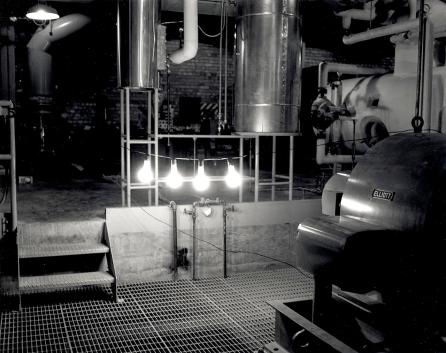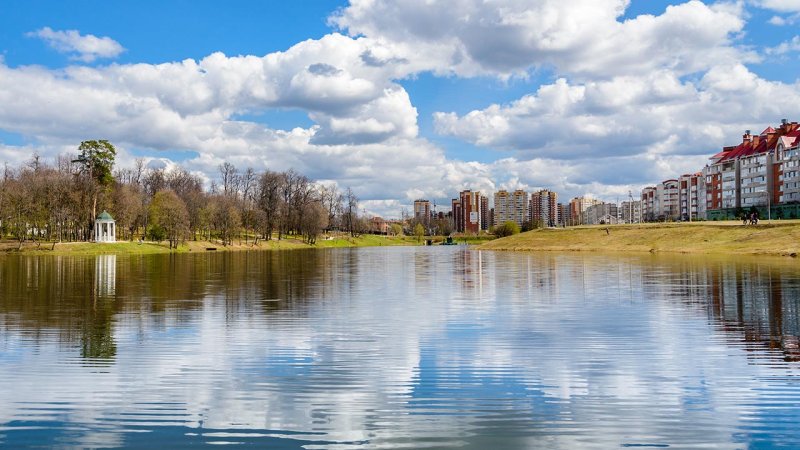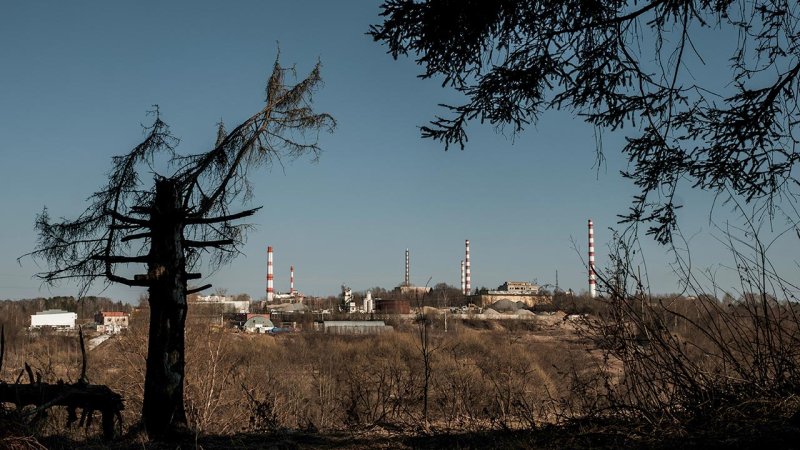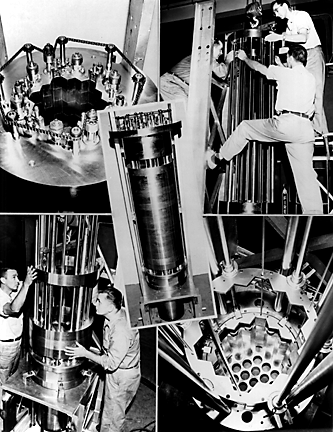
The First Reactor
4 min read
In 1938, Enrico Fermi (29. 9. 1901 — 28. 11. 1954) was awarded a Nobel Prize in Sweden for confirmation of the existence of new radioactive elements created by neutron radiation and for his discovery of nuclear reactions caused by slow neutron bombardment. The same year, he escaped the Nazis from Sweden to the USA where he later became part of the Manhattan Project. Its goal was to exploit nuclear energy.
Chicago Pile No. 1
A drawing of the first reactor constructed at the Chicago University where a group of scientists succeeded in initiating and maintaining the first fission reaction.
The first controlled fission chain reaction was initiated on December 2nd, 1942 at 15:00 under Stagg Field at the University of Chicago. Fermi and his collaborators had built a graphite nuclear reactor. It was a pile four meters high and 7.5 meters wide constructed of graphite blocks interspersed with blocks of enriched uranium. The reactor core was shaped as a flat ellipsoid. The original intent was to construct a spherical reactor core but according to Fermi’s calculations, a smaller structure was also sufficient. The pile contained 350 tons of graphite, 36 tons of uranium oxide, and 5.6 tons of metal uranium. The cost was 1 million USD.
The reactor power was controlled manually by the insertion of cadmium rods. Safety was provided by a cadmium rod suspended on a rope above the pile by a “group of suiciders” with buckets full of cadmium salt solution to be splashed onto the reactor if needed and a large rubberized balloon that could be dropped down and used to extinguish any eventual fire. However, there was no need to intervene: the reactor functioned exactly as expected.
The entire experiment took about 20 minutes and it was witnessed by 30 physicists using simple measurement devices. The reactor’s power output was 0.5 W and the pile was heated up by several degrees Celsius during its operation.
The EBR-1 was originally known as Chicago Pile No. 4, or “Zinn’s Infernal Pile” (named after Walter H. Zinn, the designer).
The First Power Plant
The first production of usable nuclear electricity occurred on December 20, 1951, when four light bulbs were lit with electricity generated from the EBR-1 reactor.
The first experimental nuclear power plant was the EBR-1 in Idaho. Its power output was about 100 W and on December 20, 1951, it powered 4 light bulbs by the first electricity generated by a nuclear power plant. The next day, it was able to power the entire building. The goal of its creators was not the generation of electricity, but to see if a nuclear reactor was able to produce more fuel than it consumed. It was a breeder reactor (EBR, Experimental Breeder Reactor), where fission caused by fast un-moderated neutrons takes place and plutonium is produced by a reaction between the neutrons and uranium 238U. This plutonium may then be used as nuclear fuel.
The first nuclear power plant connected to the grid was put into operation on June 27, 1954. It was the Russian power plant near Obninsk. Its power output was 5 MW (thermal power output of 30 MW). It was a RBMK type plant that used ordinary water as the coolant and graphite as the moderator. This type of reactor is used for both electricity generation and for the production of plutonium.
The term “nuclear reactor” was used for the first time in 1952.
The first nuclear submarine, the USS Nautilus, was launched in 1955.



![A drawing of the first reactor constructed at the Chicago University where a group of scientists succeeded in initiating and maintaining the first fission reaction. (Archival Photographic File, [apf2-00501r], Special Collections Research Center, University of Chicago Library.) A drawing of the first reactor constructed at the Chicago University where a group of scientists succeeded in initiating and maintaining the first fission reaction. (Archival Photographic File, [apf2-00501r], Special Collections Research Center, University of Chicago Library.)](/cache/img/8-b/data-web-img-nuclear-energy-the-nuclear-reactors-the-first-reactor-apf2-00501r.fitbox.x446.y2090.r0.q75.nr0.me2.jpg)
![A photograph of the first nuclear reactor. A group of scientists on the balcony records the first manmade fission chain reaction. The reaction was terminated after 28 minutes by insertion of a cadmium rod into the reactor. (Archival Photographic File, [apf2-00504r], Special Collections Research Center, University of Chicago Library.)](/cache/img/2-b/data-web-img-nuclear-energy-the-nuclear-reactors-the-first-reactor-apf2-00504r.clip.x800.y450.r0.q85.nr0.me2.co0.jpg)
![A photograph taken in November 1942 during construction of the first nuclear reactor in the world by a group of scientists headed by Enrico Fermi. There are 18 layers of metallic uranium; the 19th layer is composed of pure graphite. (Archival Photographic File, [apf2-00502r], Special Collections Research Center, University of Chicago Library.)](/cache/img/0-a/data-web-img-nuclear-energy-the-nuclear-reactors-the-first-reactor-apf2-00502r.clip.x800.y450.r0.q85.nr0.me2.co0.jpg)
![A drawing of the first successful graphite-moderated nuclear reactor, which opened the door to usage of the controlled fission reaction’s energy. An operator inserts a cadmium control rod into the reactor. (Archival Photographic File, [apf2-00503r], Special Collections Research Center, University of Chicago Library.)](/cache/img/3-e/data-web-img-nuclear-energy-the-nuclear-reactors-the-first-reactor-apf2-00503r.clip.x800.y450.r0.q85.nr0.me2.co0.jpg)
![Enrico Fermi selected a squash court since it had ceilings high enough to stack all 57 graphite layers used to build the reactor. (Archival Photographic File, [apf2-07646r], Special Collections Research Center, University of Chicago Library.)](/cache/img/c-0/data-web-img-nuclear-energy-the-nuclear-reactors-the-first-reactor-apf2-07646r.clip.x800.y450.r0.q85.nr0.me2.co0.jpg)





